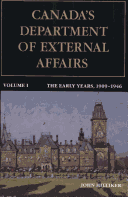Canadian Public Administration
1 primary work • 2 total works
Book 20
Canada's Department of External Affairs, Volume 2
by John Hilliker and Donald Barry
Published 1 January 1995
In 1946, with its own minister for the first time, the Department of External Affairs embarked on a period of impressive growth and assumed responsibility for a broader range of foreign policy issues than ever before. Under the expert guidance of Lester Pearson, for a decade the department enjoyed popular and parliamentary consensus about international interests. The election of the Diefenbaker government in 1957 deprived the department of Pearson's experienced ministerial direction and exposed it to new priorities and new ways of doing things. At this time foreign policy consensus began to erode. As well, there was pressure to respond to the administrative revolution inaugurated by the Royal Commission on Government Organization (the Glassco Commission) appointed in 1960. After Pearson returned to office as prime minister in 1963, questioning by the public, and also by the governing party and the cabinet, became more fervent. Coming of Age concludes in 1968 as indications of a challenge to the principles underlying Canadian foreign policy emerged from a new generation of ministers, a challenge that would produce major changes after Pierre Trudeau became prime minister.
After an introductory chapter dealing with the conduct of external relations before 1909, the book examines three distinct phases of the department's development. Although the department had modest beginnings under the first under-secretary, Sir Joseph Pope (1909-1925), it was seen by his successor, O.D. Skelton, as an important instrument for the assertion of Canadian autonomy. Skelton presided over the establishment of the first Canadian diplomatic missions abroad, and was responsible for the creation of a foreign service to staff them. With the outbreak of the war in 1939, both the responsibilities and the size of the department underwent substantial organizational change under Norman Robertson, who became under-secretary after Skelton's death in 1941. Taken together, the criteria for recruitment introduced by Skelton and the reorganization which took place under Robertson gave the department many of the features which have characterized it as a branch of the Canadian government. The further development of the institution will be examined in a second volume covering the years 1946-1968.
Since the prime minister was secretary of state for External Affairs during much of the period covered by volume I, the book contributes to an understanding of the operation of the Canadian government as a whole as well as of a single department. It also examines the policy making process and therefore will be of interest to students of international relations as well as of public administration.
Since the prime minister was secretary of state for External Affairs during much of the period covered by volume I, the book contributes to an understanding of the operation of the Canadian government as a whole as well as of a single department. It also examines the policy making process and therefore will be of interest to students of international relations as well as of public administration.

